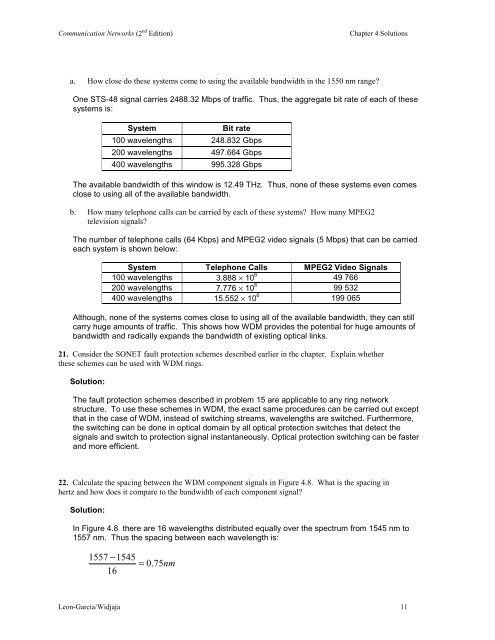Solutions to Chapter 4 - Communication Networks
Solutions to Chapter 4 - Communication Networks
Solutions to Chapter 4 - Communication Networks
Create successful ePaper yourself
Turn your PDF publications into a flip-book with our unique Google optimized e-Paper software.
<strong>Communication</strong> <strong>Networks</strong> (2 nd Edition)<br />
<strong>Chapter</strong> 4 <strong>Solutions</strong><br />
a. How close do these systems come <strong>to</strong> using the available bandwidth in the 1550 nm range<br />
One STS-48 signal carries 2488.32 Mbps of traffic. Thus, the aggregate bit rate of each of these<br />
systems is:<br />
System<br />
Bit rate<br />
100 wavelengths 248.832 Gbps<br />
200 wavelengths 497.664 Gbps<br />
400 wavelengths 995.328 Gbps<br />
The available bandwidth of this window is 12.49 THz. Thus, none of these systems even comes<br />
close <strong>to</strong> using all of the available bandwidth.<br />
b. How many telephone calls can be carried by each of these systems How many MPEG2<br />
television signals<br />
The number of telephone calls (64 Kbps) and MPEG2 video signals (5 Mbps) that can be carried<br />
each system is shown below:<br />
System Telephone Calls MPEG2 Video Signals<br />
100 wavelengths 3.888 × 10 6 49 766<br />
200 wavelengths 7.776 × 10 6 99 532<br />
400 wavelengths 15.552 × 10 6 199 065<br />
Although, none of the systems comes close <strong>to</strong> using all of the available bandwidth, they can still<br />
carry huge amounts of traffic. This shows how WDM provides the potential for huge amounts of<br />
bandwidth and radically expands the bandwidth of existing optical links.<br />
21. Consider the SONET fault protection schemes described earlier in the chapter. Explain whether<br />
these schemes can be used with WDM rings.<br />
Solution:<br />
The fault protection schemes described in problem 15 are applicable <strong>to</strong> any ring network<br />
structure. To use these schemes in WDM, the exact same procedures can be carried out except<br />
that in the case of WDM, instead of switching streams, wavelengths are switched. Furthermore,<br />
the switching can be done in optical domain by all optical protection switches that detect the<br />
signals and switch <strong>to</strong> protection signal instantaneously. Optical protection switching can be faster<br />
and more efficient.<br />
22. Calculate the spacing between the WDM component signals in Figure 4.8. What is the spacing in<br />
hertz and how does it compare <strong>to</strong> the bandwidth of each component signal<br />
Solution:<br />
In Figure 4.8 there are 16 wavelengths distributed equally over the spectrum from 1545 nm <strong>to</strong><br />
1557 nm. Thus the spacing between each wavelength is:<br />
1557 −1545<br />
= 0.75nm<br />
16<br />
Leon-Garcia/Widjaja 11







